Related Research Articles

Willa Sibert Cather was an American writer known for her novels of life on the Great Plains, including O Pioneers!, The Song of the Lark, and My Ántonia. In 1923, she was awarded the Pulitzer Prize for One of Ours, a novel set during World War I.

An intimate relationship is an interpersonal relationship that involves emotional or physical closeness between people and may include sexual intimacy and feelings of romance or love. Intimate relationships are interdependent, and the members of the relationship mutually influence each other. The quality and nature of the relationship depends on the interactions between individuals, and is derived from the unique context and history that builds between people over time. Social and legal institutions such as marriage acknowledge and uphold intimate relationships between people. However, intimate relationships are not necessarily monogamous or sexual, and there is wide social and cultural variability in the norms and practices of intimacy between people.
An only child is a person with no siblings, by birth or adoption.

Lucifer was a journal published by Helena Blavatsky. The first edition was issued in September 1887 in London. The journal published articles on philosophical, theosophical, scientific and religious topics. It also contained book reviews, for example of Friedrich Nietzsche's Thus Spoke Zarathustra.
Jorge de Menezes was a Portuguese explorer. Due to a monsoon, he was forced to reside in Versya, posited by Pieter Anton Tiele as Waisai, between 1526 and 1527. Menezes called the region Ilhas dos Papuas, though the name of "Papua" was already known at the time. Yet he was still the first European to go ashore and thus credited with the European discovery of New Guinea.

The pallid bat is a species of bat that ranges from western Canada to central Mexico. It is the sole species of its genus and is closely related to Van Gelder's bat, which is sometimes included in Antrozous. Although it has in the past been placed in its own subfamily (Antrozoinae) or even family (Antrozoidae), it is now considered part of the subfamily Vespertilioninae and the tribe Antrozoini.

Chaos: Making a New Science is a debut non-fiction book by James Gleick that initially introduced the principles and early development of the chaos theory to the public. It was a finalist for the National Book Award and the Pulitzer Prize in 1987, and was shortlisted for the Science Book Prize in 1989. The book was published on October 29, 1987 by Viking Books.

Pambo of Nitria was a Coptic Desert Father of the fourth century and disciple of Anthony the Great. His feast day is July 18 among the Oriental Orthodox, Eastern Orthodox, and Catholic churches.
George Woodman Hilton was a United States historian and economist, who specialized in social history, transportation economics, regulation by commission, the history of economic thought and labor history.

The Fort Union Formation is a geologic unit containing sandstones, shales, and coal beds in Wyoming, Montana, and parts of adjacent states. In the Powder River Basin, it contains important economic deposits of coal, uranium, and coalbed methane.

Simon Nelson Patten was an American economist and the chair of the Wharton School of Business at the University of Pennsylvania. Patten was one of the first economists to posit a shift from an 'economics of scarcity' to an 'economics of abundance'; that is, he believed that soon there would be enough wealth to satisfy people's basic needs and that the economy would shift from an emphasis on production to consumption.

Pseudhipparion is an extinct genus of three-toed horse endemic to North America during the Miocene. They were herding animals whose diet consisted of C3 plants. Fossils found in Georgia and Florida indicate that it was a lightweight horse, weighing up to 90 pounds. In 2005, fossils were unearthed in Oklahoma. Seven species of Pseudhipparion are known from the fossil record which were very small, following the trend of Bergmann's rule.

Cormohipparion is an extinct genus of horse belonging to the tribe Hipparionini that lived in North America during the late Miocene to Pliocene. They grew up to 3 feet long.
Gloria Lund Main is an American economic historian who is a professor emeritus of history at University of Colorado Boulder. She authored two books about the Thirteen Colonies.

Paleontology in Oklahoma refers to paleontological research occurring within or conducted by people from the U.S. state of Oklahoma. Oklahoma has a rich fossil record spanning all three eras of the Phanerozoic Eon. Oklahoma is the best source of Pennsylvanian fossils in the United States due to having an exceptionally complete geologic record of the epoch. From the Cambrian to the Devonian, all of Oklahoma was covered by a sea that would come to be home to creatures like brachiopods, bryozoans, graptolites and trilobites. During the Carboniferous, an expanse of coastal deltaic swamps formed in areas of the state where early tetrapods would leave behind footprints that would later fossilize. The sea withdrew altogether during the Permian period. Oklahoma was home a variety of insects as well as early amphibians and reptiles. Oklahoma stayed dry for most of the Mesozoic. During the Late Triassic, carnivorous dinosaurs left behind footprints that would later fossilize. During the Cretaceous, however, the state was mostly covered by the Western Interior Seaway, which was home to huge ammonites and other marine invertebrates. During the Cenozoic, Oklahoma became home to creatures like bison, camels, creodonts, and horses. During the Ice Age, the state was home to mammoths and mastodons. Local Native Americans are known to have used fossils for medicinal purposes. The Jurassic dinosaur Saurophaganax maximus is the Oklahoma state fossil.

Ehud R. Toledano is professor of Middle Eastern history at Tel Aviv University and the current director of the Program in Ottoman & Turkish Studies. His areas of specialization are Ottoman history, and socio-cultural history of the modern Middle East.

The Ash Hollow Formation of the Ogallala Group is a geological formation found in Nebraska and South Dakota. It preserves fossils dating back to the Neogene period. It was named after Ash Hollow, Nebraska and can be seen in Ash Hollow State Historical Park. Ashfall Fossil Beds State Historical Park is within this formation.

Huck's Raft is a history of American childhood and youth, written by Steven Mintz. The 2006 H-Net review wrote that the book was the best single-volume history of its kind.
The Origins of American Social Science is a 1991 book by Dorothy Ross on the early history of social science in the United States.
Noah's wife is one of the four wives aboard Noah's Ark. While nameless in the Bible, apocryphal literature lists 103 variations of her name and personality.
References
- ↑ Foshay, Toby A.; Forshay, Toby A. (1983). "Yeats's "Nineteen Hundred and Nineteen": Chronology, Chronography and Chronic Misreading". The Journal of Narrative Technique. 13 (2): 100–108. ISSN 0022-2925. JSTOR 30225063.
- ↑ Lavan, Rosie (10 January 2020). ""Number Weight & Measure:" "Nineteen Hundred and Nineteen" and the Labor of Imagination". International Yeats Studies. 4 (1): 81–90. doi: 10.34068/IYS.04.01.06 . ISSN 2475-9627.
- ↑ Sheehan, Rebecca (2009). "Competing with "The Barbarous Clangour of a Gong": Why "Theme of the Traitor and the Hero" Begins in "Nineteen Hundred and Nineteen"". Journal of Modern Literature. 32 (3): 22–38. doi:10.2979/JML.2009.32.3.22. ISSN 0022-281X. JSTOR 25511817. S2CID 162277837.
- ↑ Doggett, Rob (2001). "Writing out (Of) Chaos: Constructions of History in Yeats's "Nineteen Hundred and Nineteen" and "Meditations in Time of Civil War"". Twentieth Century Literature. 47 (2): 137–168. doi:10.2307/827847. ISSN 0041-462X. JSTOR 827847.
- ↑ Wood, Michael (24 June 2010). Yeats and Violence. Oxford University Press. doi:10.1093/acprof:oso/9780199557660.001.0001. ISBN 978-0-19-955766-0.